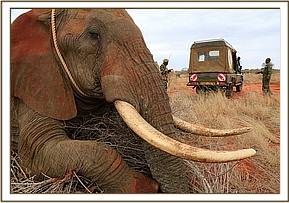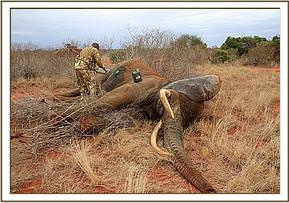Once again on the 15th of September, a day plagued by sightings of elephants with injuries as a result of ivory poaching, the DSWT’s chief pilot, Nick Trent working in conjuction with KWS, noticed another big handsome bull clearly in need of urgent attention
Once again on the 15th of September, a day plagued by sightings of elephants with injuries as a result of ivory poaching, the DSWT’s chief pilot, Nick Trent working in conjuction with KWS, noticed another big handsome bull clearly in need of urgent attention.
//www.youtube.com/watch?v=6PVhRjCN6GkWith good-sized tusks and walking alone, the bull’s wound was clearly visible on his flank, gushing with puss as he moved slowly along. Fortunately that day both the DSWT helicopter and Tsavo Mobile Veterinary Unit with Dr.Poghon, a KWS vet officer, were close at hand so that treatment could be rapidly arranged before the bull disappeared into the vast landscape of Tsavo.


The Tsavo veterinary team vehicle was deployed first before the DSWT helicopter was launched yet again with KWS Veterinary Officer Dr Poghon on-board with his prepared darts. Just five minutes later the helicopter had located the elephant and Dr Poghon’s dart, with its bright pink marker feathers, was firmly lodged in the elephant’s behind.
In no time at all the patient succumbed to the anesthetizing drug, slumping onto his haunches. This was not an ideal position due to the pressure it places on the vital organs, so the bull was quickly roped and rolled onto his side by the DSWT/KWS ground team who were ready onsite, before treatment could commence.


Landing close to the elephant in the helicopter, Dr Poghon was quick to remove a bent poisoned arrow from the bull’s side; the bending is assumed to be as a result of the arrow hitting a bone. The treatment went swiftly and successful, the team working together to give this bull the very best chance of survival. By being identified and treated in good time this bull now has an extremely high chance of making a full recovery from the poacher’s lethal poison.


Whilst these activities were taking place, Neville Sheldrick, another of the DSWT’s dedicated pilots, had sighted yet more wounded elephants. Utilising the helicopter and its pilot Humphrey Carter once again, Dr Poghon had the opportunity, in a very short time, to view each of the sighted injured elephants safely and at close range.
Flying from group to group, Dr Poghon was able to look closely at each of the elephants’ wounds from the helicopter determining that most of the elephants had arrow wounds, which were luckily healing well, whilst one very big bull needed urgent treatment and one elephant had a wound, which needed closer examination.
The DSWT’s Aerial Surveillance Unit, Anti-Poaching ground teams and Mobile Veterinary Unit working closlely with KWS rangers and vets are working tirelessly in the field providing constant support for these victims of poaching. Please support these initiatives however you can by donating through our website here.